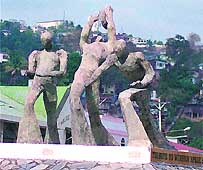|
|
Remembering ‘Spree’ Simon

THE monument to Winston “Spree” Simon in John John.
Photo: KEINO DEVENISH
April 18, 2001
By Terry Joseph
TODAY marks the 25th anniversary of his death, but mere mention of the name Winston “Spree” Simon in the pan fraternity still elicits emotion and creates controversy.
While a large body of pan enthusiasts insists he was the first person to play a recognisable tune on pan, there are those who contend it could not have been Spree.
Interestingly, Spree himself never publicly claimed that distinction. It is an accolade pinned to his chest largely by proud fellow villagers from the John John area where he grew up.
Born at Rose Hill, East Dry River in 1930, his detractors say he would have been too young to shine at the time pan made that first developmental leap. What is not in dispute is that Spree executed the best-remembered pan performance of the 1946 Carnival. And since that event is widely recorded as the first time the instrument had been used as a lead voice in the yet fledgling steel orchestra, it seems more than reasonable to link both situations.
Several pan historians, some of whom were probably on hand for his public premiere of the 14-note tenor pan on March 5, 1946 (Carnival Tuesday of that year), insist that no one had hitherto produced that level of music.
To the delight of the Broadway Carnival competition audience, which included then Governor Sir Bede Clifford and Lady Clifford, socialite Audrey Jeffers and calypsonian Lord Kitchener, Spree played Schubert’s “Ave Maria”, the hymn “God Save the King” and Kitchener’s “Lai Fook Lee”; the 1946 Road March.
It is useful to remember that the speed of communication in 1946 was not what it is today. Indeed, it is possible that similar developments might well have been taking place in other centres, so claims coming from those quarters cannot be summarily dismissed.
But Spree’s larger value to pan history is almost vulgarised by the controversial claim. His importance to pan lore is far more substantial.
Living in John John, Spree was virtually ringed by factories producing biscuits and other products that used drums. Discards from those industries gave him his first “kettle-drum” and it was an accident with this prototype that prodded him to create the 14-note pan.
Since African drumming did not find favour with the authorities, he decided to investigate the possibility of making music from the tins.
His kettle-drum was a rudimentary one-note instrument, used largely for percussive highlighting in what was essentially an elaborate rhythm section, euphemistically called a band.
As the story goes, one night when the band was taking a jamthrough the district, he loaned his instrument to a fellow member. Upon retrieving the pan, Spree discovered it had been brutalised, much of its original convex playing surface had been beaten inward.
It was in trying to repatriate the original shape to the pan (by beating it from inside with a big stone), he discovered different sounds coming from the various areas of the playing surface. By alternately using a piece of wood, he was able to vary tone. Spree produced a four-note pan from this experiment.
The ban on Carnival occasioned by World War II (1939-1945) gave Spree ample opportunity to develop his work. By 1943, he improved his pan’s capacity to nine clear notes on the convex surface and three years later astonished listeners with the 14-note version.
Spree was therefore an automatic selection for the ground-breaking Trinidad All Stars Percussion Orchestra (TASPO), which took a full band on a tour of London and Paris in 1951, introducing the instrument to Europe.
During his early years, Spree led three steelbands in the area—Tropical Harmony, Fascinators and one named after a war-propaganda movie Destination Tokyo, now known as Carib Tokyo.
Most of his life served as an inspiration to several aspiring tuners and he imparted his knowledge freely to many of them.
In 1970, Spree’s health began a rapid deterioration. A stroke reduced his involvement in pan to a minimum and he eventually succumbed on April 18, 1976. His presence on the pan scene is immortalised in several calypsoes, most notably Kitchener’s “Winston ‘Spree’ Simon” and Merchant’s “Pan in Danger”.
Winston “Spree” Simon brought pan to its first watershed and thus carved his name forever in steel, going to his grave without formal national award recognition.
On Saturday, the John John Development Community pays tribute to Winston “Spree” Simon at the Carib Tokyo panyard in a variety presentation beginning at 6 p.m.
Previous Page

Panorama 2001 Events
Archives Steelpan Origins
|


